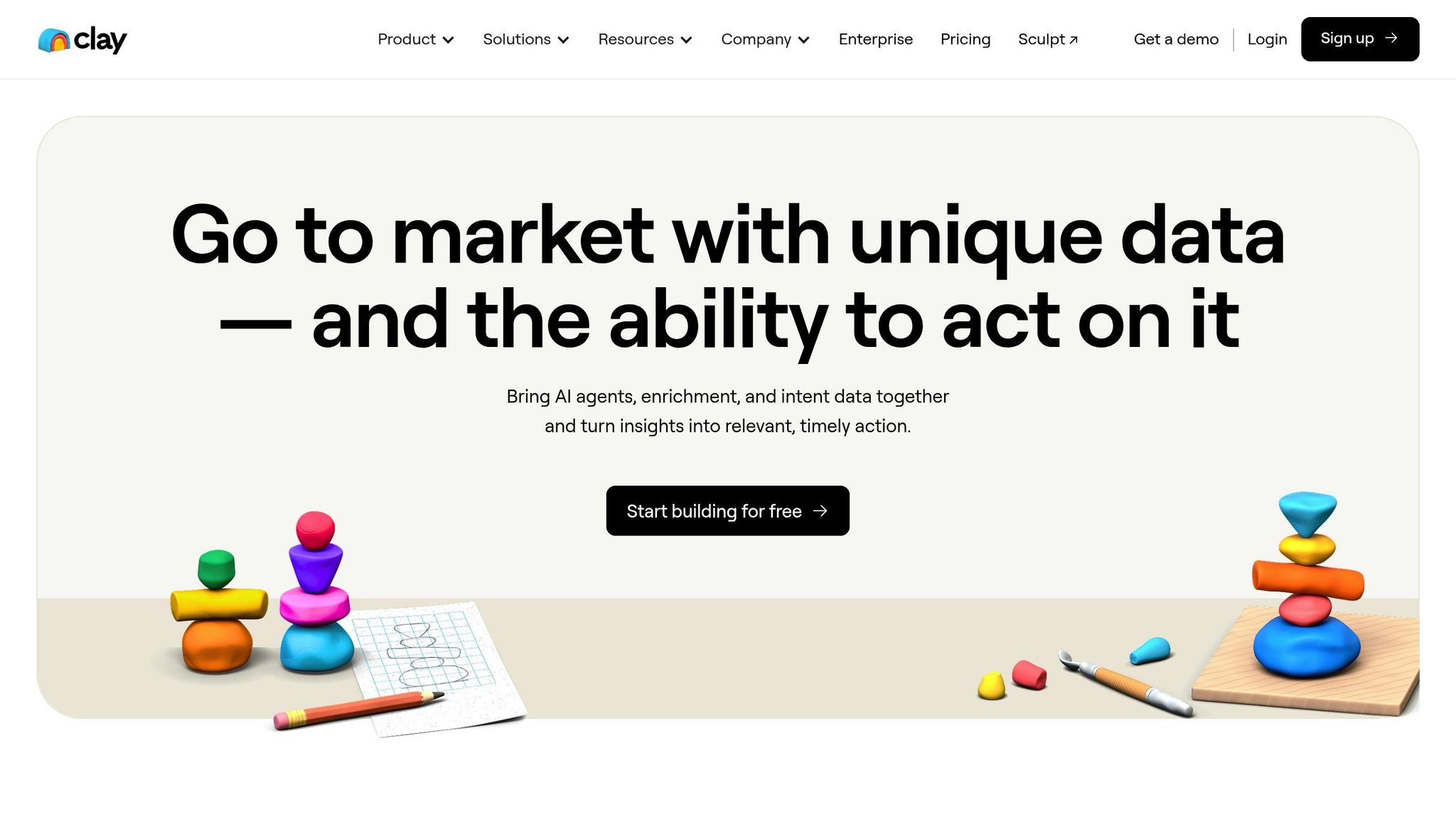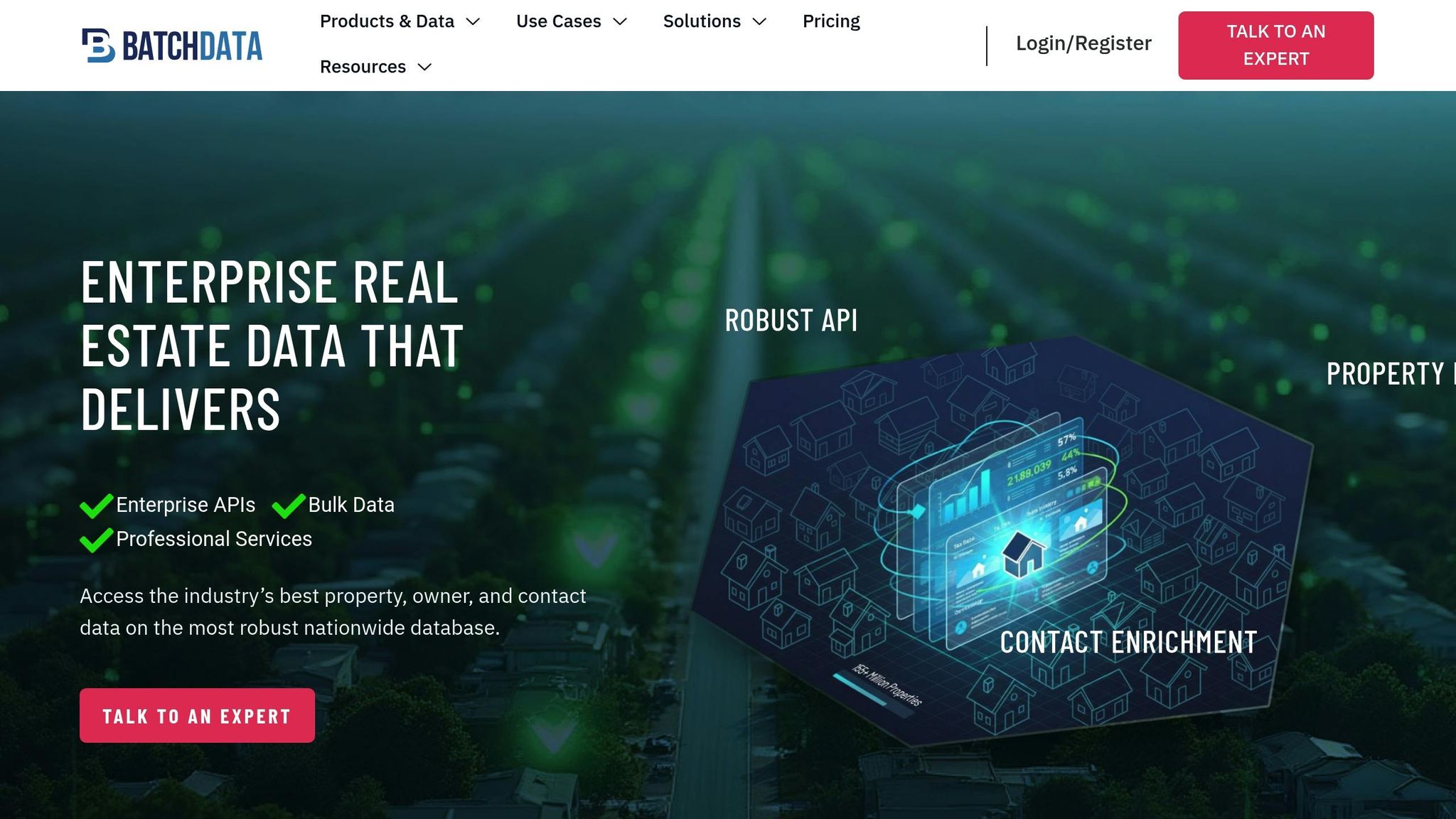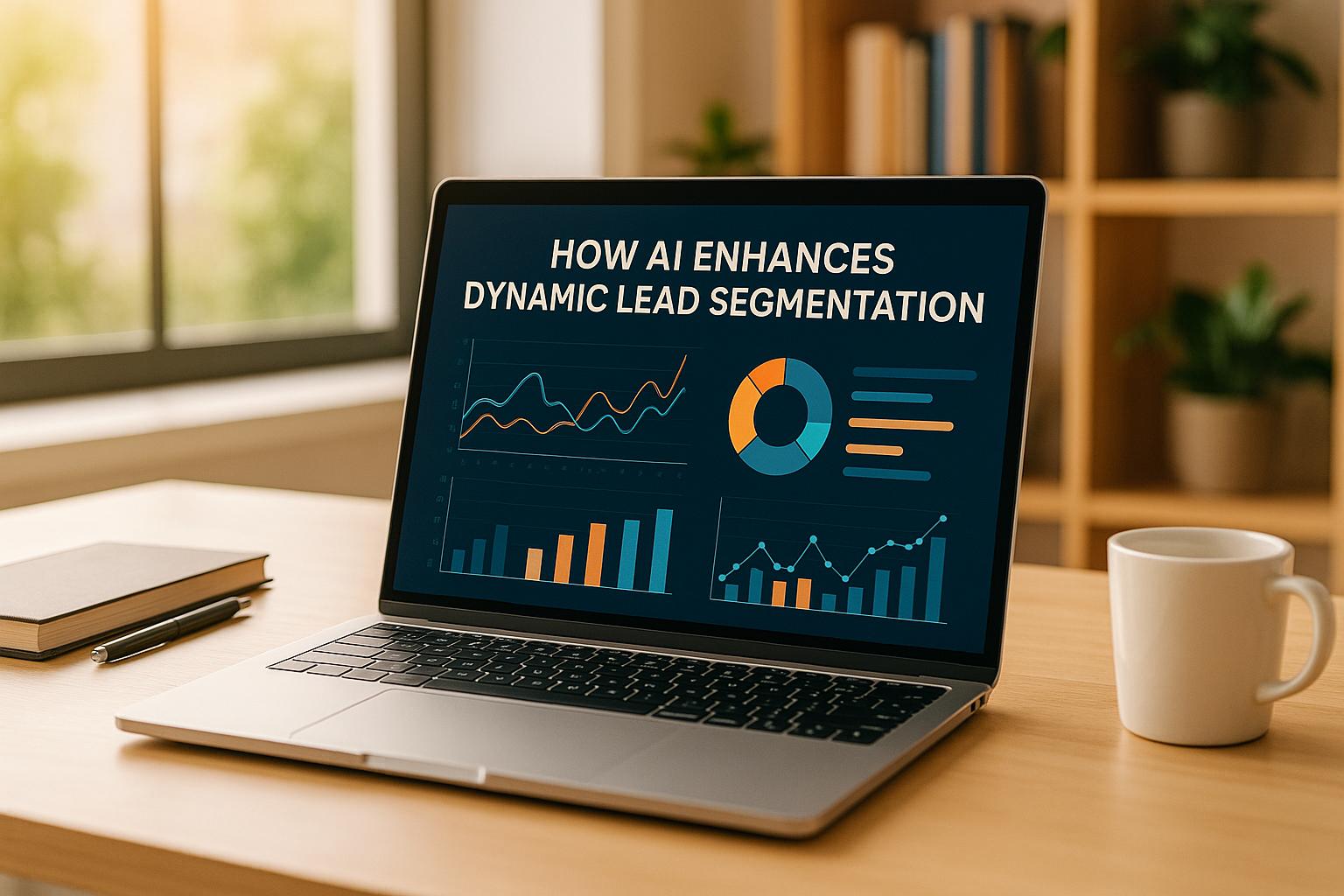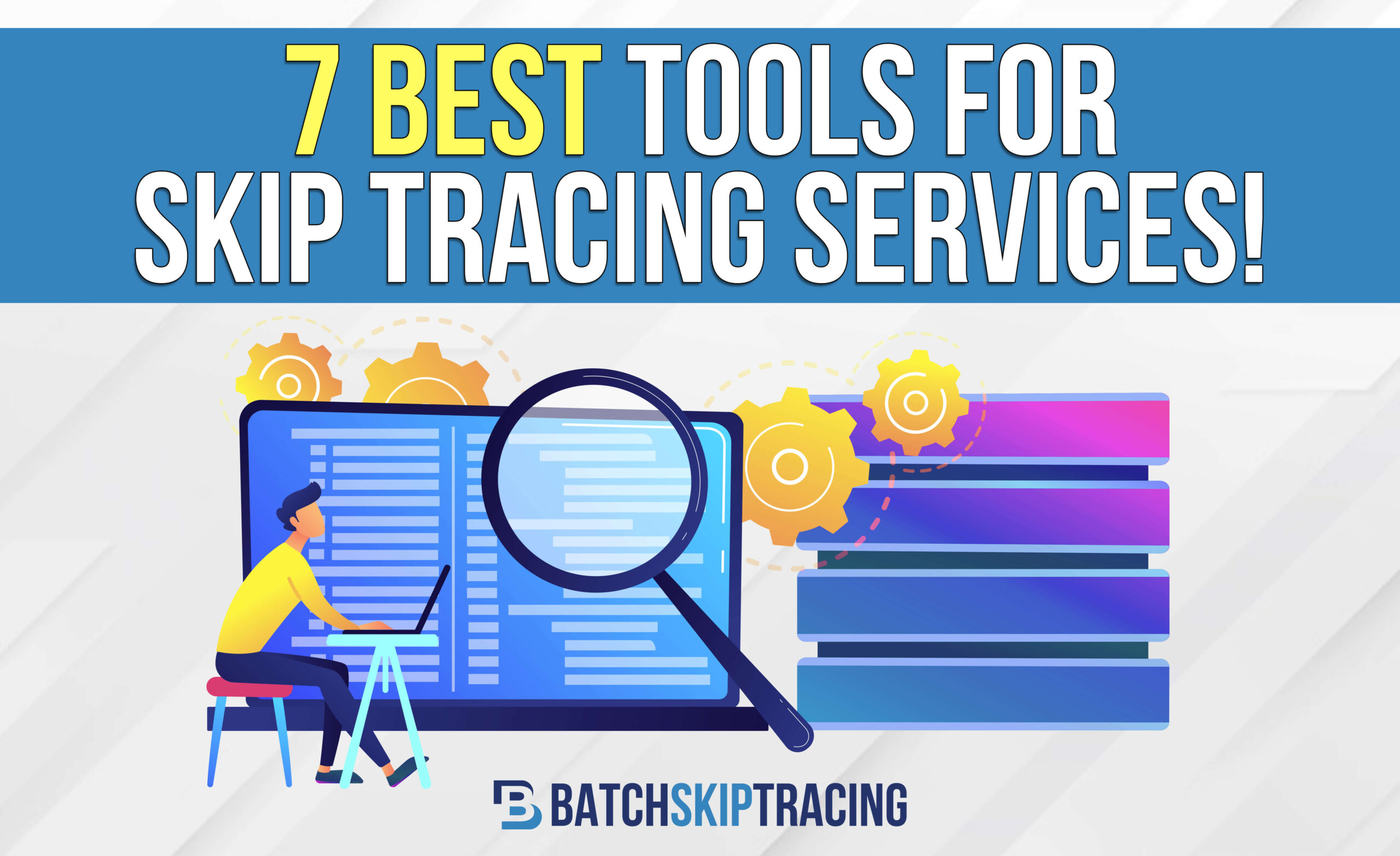AI transforms lead segmentation by automating data analysis, identifying patterns in customer behavior, and improving lead prioritization in real time. Traditional manual methods struggle with large datasets and evolving customer actions, but AI-powered systems excel in processing vast amounts of information quickly and accurately. Key benefits include:
- Improved lead scoring: AI increases conversion rates by up to 52% and accelerates lead qualification by 60%.
- Behavioral insights: AI detects patterns like browsing habits and engagement trends to identify high-intent leads.
- Predictive analytics: AI uses historical data to forecast conversion likelihood and prioritize leads effectively.
- Real-time segmentation: AI updates lead classifications instantly based on new actions or market changes.
- Data quality focus: Reliable, enriched data is essential for precise AI-driven segmentation.
Businesses using AI for lead segmentation can better allocate sales efforts, reduce administrative tasks, and respond quickly to shifts in customer behavior, ultimately driving higher revenue and efficiency.
Outbound Playbooks: AI Lead List Segmentation in Clay 🤖

AI-Powered Behavioral Analysis for Lead Segmentation
AI has taken lead segmentation to the next level by diving deep into user behavior. By analyzing interactions like browsing habits and engagement patterns, AI creates a detailed picture of each lead’s potential to convert. This approach goes beyond traditional methods, offering a clearer understanding of what drives each prospect.
Modern AI systems can process vast amounts of data simultaneously, tracking metrics such as navigation patterns and engagement rates. This allows for the creation of behavioral profiles that manual methods simply can’t match.
For example, AI can distinguish between a lead with strong buying intent and another who’s just casually browsing. By analyzing the timing and nature of interactions, sales teams can reach out to prospects at the most opportune moments, increasing the chances of conversion.
How Machine Learning Enhances Lead Categorization
Machine learning takes lead categorization a step further by continuously learning from past conversion data. These models analyze historical outcomes to uncover patterns in behavior that signal high-quality leads more effectively than traditional methods. By combining behavioral markers with past data, machine learning can identify trends and correlations that might go unnoticed through manual analysis.
These algorithms assign probability scores based on behavioral insights, estimating the likelihood of conversion. This scoring system helps sales teams focus their efforts on leads that are most likely to close, streamlining the sales process and boosting efficiency.
Greater Precision in Identifying High-Intent Leads
AI excels at pinpointing leads who are ready to make purchasing decisions. In industries like real estate, for instance, AI analyzes user behavior, priorities, and demographic information to identify high-potential buyers or tenants. Behavioral signals often provide a more accurate picture of a prospect’s readiness to buy than demographic data alone.
Using Predictive Analytics for Lead Scoring and Prioritization
Predictive analytics is reshaping the way businesses approach lead scoring by taking the guesswork out of the process. Instead of relying on intuition or simple demographic data, AI systems analyze complex patterns within large datasets to predict which prospects are most likely to convert. These systems assign probability scores to each lead, creating a prioritized list that directs sales teams to focus on the leads that matter most.
What’s even better? These predictions don’t remain static. As new outcomes are fed into the system, it continuously refines its accuracy, uncovering subtle patterns that might go unnoticed by human analysis. This ongoing improvement helps businesses make the most of their historical data, turning past insights into smarter lead scoring strategies.
Using Historical Data for Predictive Insights
Historical data provides the backbone for predictive lead scoring. By analyzing past customer journeys, AI systems can pinpoint the behaviors, interactions, and traits that are most often linked to successful conversions. This deep dive into past performance helps businesses understand what a "high-potential" lead looks like.
Take financial indicators, for example. Historical transaction values and payment habits can reveal not only how likely a lead is to convert but also their potential lifetime value. With this information, sales teams can prioritize leads that offer both a high probability of conversion and significant revenue potential.
Behavioral data also plays a big role. AI systems examine patterns from past successful conversions, such as time spent on certain pages, how often a lead engages with content, or how quickly they respond to communications. These insights build a detailed profile of what high-converting leads tend to do during their buyer’s journey.
Seasonal trends and shifts in market conditions add yet another layer of depth. By analyzing when certain types of leads are more likely to convert, AI helps sales teams adjust their strategies to align with timing and market dynamics. This level of precision ensures that no opportunity is left untapped.
Better Time Allocation with AI-Driven Lead Scoring
AI-driven lead scoring transforms how sales teams allocate their time by offering clear, data-backed priorities. Instead of working through leads in a random order or based on when they came in, teams can focus on leads with the highest conversion potential. For example:
- High-scoring leads (80-100) receive immediate attention.
- Medium-scoring leads (50-79) are placed into nurturing campaigns.
- Low-scoring leads (below 50) are handled through automated workflows.
And here’s the game-changer: lead scores are dynamic. A lead that initially scored low might move into high-priority territory after revisiting pricing pages or downloading key resources. This real-time adjustment ensures sales teams are always working with the most up-to-date information.
Sales managers also benefit from AI-driven scoring. They can track team performance more effectively and assign leads based on individual strengths. For instance, if one salesperson excels at converting high-value leads, they can focus on those opportunities, while others handle nurturing or lower-priority tasks. This tailored approach boosts overall team performance.
Beyond individual productivity, AI-driven prioritization significantly reduces time spent on administrative tasks like lead qualification. Sales teams can focus more on building relationships and closing deals, leading to shorter sales cycles and higher conversion rates throughout the funnel. It’s a win-win for both efficiency and effectiveness.
sbb-itb-8058745
Real-Time Dynamic Segmentation: Adapting to Changing Data
Real-time dynamic segmentation is revolutionizing lead management by making it faster and more responsive. Instead of relying on weekly or monthly updates, this approach continuously monitors behaviors and adjusts segments within minutes. A lead’s classification can shift almost instantly based on their latest actions, engagement trends, or even external market signals.
The real power of real-time segmentation lies in its ability to capture those small but crucial moments that influence decisions. For instance, if a lead downloads a pricing guide or checks out competitor comparisons, the system updates their segment immediately. This ensures sales teams always have the most up-to-date and actionable insights about their leads.
Market changes also play a big role in segmentation strategies. Economic shifts, industry updates, or seasonal trends can all impact how leads behave and what they’re looking for. By analyzing incoming data in real time, AI systems can spot these patterns and adjust classifications on the fly. This constant recalibration helps businesses stay ahead and align their strategies with current conditions, complementing predictive analytics for even better results.
Static vs. Real-Time Segmentation: Performance Comparison
It’s worth looking at how static and real-time segmentation stack up against each other. Static segmentation relies on periodic updates, which can quickly become outdated. On the other hand, real-time segmentation integrates the most recent data as it comes in. This leads to quicker response times, more accurate lead qualification, and a more agile sales process. With real-time insights, teams can engage leads at the exact moment their interest peaks, boosting overall sales efficiency.
These systems also make it possible to take immediate action, like sending priority alerts, launching personalized communications, or updating content dynamically. This ability to respond quickly to behavioral signals often determines whether a lead is engaged at their highest point of interest or if the opportunity is missed altogether.
Impact of Real-Time Updates on Lead Management
The advantages of real-time updates go beyond segmentation – they transform lead management across the entire sales cycle. By shifting from a reactive to a proactive approach, teams gain a clearer view of where leads are in their buyer journey. AI systems can detect subtle changes in engagement, such as repeated visits to pricing pages or extended time spent on case studies, and adjust lead priorities accordingly.
This proactive capability also improves territory and timing strategies. For example, if a lead’s company announces new funding or plans for expansion, the system can raise their priority and route them to the right sales representative. Similarly, if market conditions suggest a shift in buying behavior, leads from affected industries can be re-prioritized in real time.
Real-time segmentation also strengthens pipeline forecasting. Sales managers can access up-to-the-minute insights into lead progression, making revenue predictions more accurate and aligning outreach strategies with current market conditions. Additionally, these systems can quickly identify negative signals – like a drop in engagement or increased activity on competitor websites – allowing teams to act fast with retention strategies before losing the lead.
Data Quality: The Foundation of Effective AI Lead Segmentation
AI is only as good as the data it works with. Poor or incomplete data hampers its effectiveness, while enriched, consistent data creates a comprehensive view of leads, enabling precise segmentation. High-quality data allows AI to detect subtle behavioral patterns and predictive signals, leading to highly targeted segmentation strategies.
Take this example: A basic lead profile might show an interest in real estate. But with enriched data, the AI could uncover that this individual owns multiple properties and recently refinanced a loan. With this added context, the AI can classify them as a high-value investor rather than just a general prospect. This level of detail transforms generic classifications into actionable insights.
Standardized and clean data is critical for accurate pattern detection [10–13]. When information comes from various sources with inconsistent formats or naming conventions, it creates noise that can disrupt the AI’s ability to identify meaningful patterns.
Data enrichment also addresses the natural gaps that appear as leads move through the funnel. For instance, contact details often become outdated. AI-powered enrichment tools can automatically gather updated information from a wide range of online sources, ensuring lead profiles remain current and complete. This constant flow of enriched data empowers AI to segment leads proactively, setting the stage for more advanced management strategies.
How BatchData Supports Seamless Data Integration

BatchData plays a key role in maintaining data integrity by offering powerful integration solutions. Their platform enhances data quality through property and contact data enrichment, skip tracing services, and verified contact details, ensuring engagement metrics accurately reflect lead behavior.
With bulk data delivery options, BatchData makes it easy to enrich large lead databases quickly. This equips AI systems with the detailed datasets they need to identify patterns effectively. Plus, BatchData integrates smoothly with existing tools and workflows, so businesses can boost data quality without the hassle of overhauling their processes.
Conclusion: Growth Through AI-Powered Lead Segmentation
AI is reshaping how businesses approach lead segmentation by combining behavioral insights with real-time data updates. With its advanced processing abilities, AI uncovers patterns that would typically go unnoticed by human analysts. Machine learning takes it a step further, continuously improving lead classifications as new data becomes available. This shift allows businesses to move from reacting to leads after the fact to proactively managing them.
However, the success of AI-powered segmentation hinges on one critical factor: data quality. Without accurate, enriched, and standardized data, even the most advanced algorithms can falter. That’s where BatchData comes in. By offering property data enrichment, contact verification, and API solutions, BatchData ensures the data fed into AI systems is reliable and robust.
With these tools in hand, businesses can leverage AI-driven insights to stay ahead in today’s competitive, data-focused landscape. AI-powered segmentation isn’t just about organizing leads – it’s about converting them into opportunities and driving meaningful revenue growth.
FAQs
How does AI improve the accuracy of identifying high-intent leads compared to traditional methods?
AI-driven lead segmentation takes targeting to the next level by leveraging machine learning algorithms to process massive amounts of real-time data. Unlike older methods that depend on fixed rules and outdated datasets, AI evolves with shifting patterns, ensuring more accurate identification of high-intent leads.
By analyzing details like intent, urgency, and even emotional cues from both structured and unstructured data, AI zeroes in on leads that offer the most value. This leads to better lead quality, higher engagement rates, and stronger conversion opportunities – making it an essential asset for businesses aiming to stay ahead.
Why is data quality crucial for AI-driven lead segmentation, and how can businesses ensure their data is dependable?
Accurate data is the backbone of successful AI-driven lead segmentation. Without it, insights can become skewed, leading to misguided decisions and missed opportunities. High-quality data allows AI systems to spot patterns and segment leads with precision.
To keep data reliable, businesses should focus on consistent validation and cleansing routines. Prioritizing accuracy and completeness is key, and leveraging dependable data enrichment tools can make a big difference. These practices ensure AI delivers results you can count on when segmenting leads.
How does real-time dynamic segmentation improve sales strategies and business decisions?
Real-time dynamic segmentation gives businesses the ability to react swiftly to shifts in customer behavior and preferences. This means marketing strategies can be more targeted and personalized. By spotting specific customer needs and trends as they happen, companies can adjust their approach to connect with the right audience at the perfect moment, leading to higher conversion rates and improved customer satisfaction.
It also strengthens decision-making by delivering actionable insights that help fine-tune resource allocation and strategic planning. With the flexibility to adapt to changing market demands, businesses can enhance customer experiences, boost revenue, and stay ahead in competitive, fast-moving industries.



